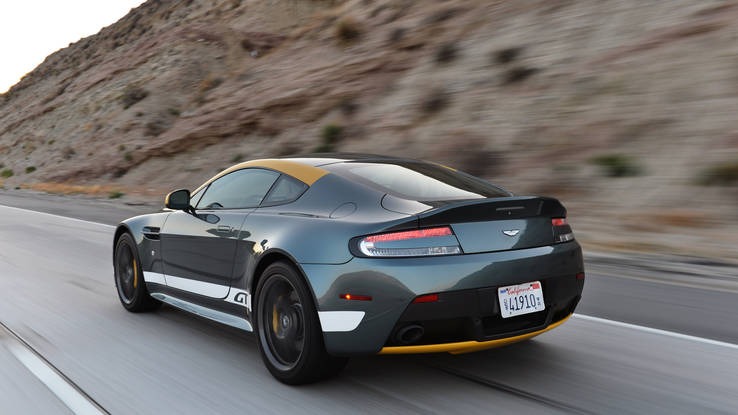We drive the entire 2016 Aston Martin lineup
On the surface, it seems like all is quiet at Aston Martin. After all, neither of the company’s core sporting cars, the Vantage or DB9, has been redesigned in more than a decade. That’s an eternity in sports-car years. In the same year the DB9 launched (2004), Chevrolet was still pushing the C5 Corvette, Porsche was happy to sell you the 996 Turbo and Ferrari’s top V12 grand-touring coupe was the 575M. Each of these automakers has replaced their cars with completely new generations — twice.
But excitement is coming. Next year, an all-new DB11 will launch. It will retain the V12 and become the first car to benefit from the recent tech partnership with Mercedes-Benz. That new DB, Aston’s chief program engineer John Caress says, will use a Mercedes-Benz electrical architecture. And that will allow Aston’s top model to finally offer just about all the safety technology in the Mercedes-Benz portfolio.
But Caress says the tech partnership will also include an AMG V8 that they’ll tune in-house and pair with a Mercedes-Benz transmission. That powertrain won’t show up for a few more years, likely when Aston remakes the Vantage. And he mentions that an all-electric version of the company’s Rapide sedans is coming, as is a production version of the high-riding DBX crossover concept before the end of the decade. In fact, Caress says that by 2020 — just four models years away — the Aston Martin showroom will look completely different than it does today.
To appreciate where the company is going, it makes sense to take stock in where they are right now. So we hit some of the best roads in Southern California’s Santa Monica Mountains to get a taste of nuanced differences in the full Aston Martin range.

Aston Martin V8 Vantage GT
Aston Martin Vantage
The V8 Vantage is Aston’s Porsche 911 competitor. It launched in 2005 with a 380-hp V8 and a six-speed manual. Since then, the V8 has grown in displacement to 4.7 liters and now puts down 430 hp. The V8 Vantage GT is the least expensive way to get into an Aston and it’s also the only one that can be optioned with a manual. You’ll want to really consider that manual, because the single-clutch automated seven-speed is a little clunky in its operation, with substantial pauses between gears in automatic mode.
But no matter which transmission is selected, this V8 sounds fantastic — especially when the sport button is pressed. This is a car that, aside from the automanual transmission, feels analog. The precise steering is almost unassisted in its weight and there’s less technology managing and filtering the driving experience than in most sports cars. The V8 GT is fun to look at, thanks to wild paint combinations (ours was green with yellow accents), and with such organic-feeling steering, it’s fun to drive too. However, on broken pavement, the GT’s ride is very firm.
The V12 Vantage S is smoother, more talented and more powerful than the GT in just about every way. The suspension tune is supple thanks to unique tuning and adaptive dampers. However the seven-speed automated manual is no better here. So yes, there are still those annoying, lurchy pauses between shifts in automatic mode. But that V12’s additional 135 hp makes the Vantage feel like a completely different animal. It’s wildly quick and it has the best soundtrack of any Aston Martin we drove. The powerband is so smooth and so wide in this car compared to the V8, it feels as though there’s potency everywhere in the rev range. It is a hugely entertaining car with serious handling capability. Aston says the V12 engine is about 200 pounds heavier than the V8. But we never noticed that extra weight. The V12 Vantage S is such fun on a snaky canyon road, you’ll forgive and forget about the dated interior and tiny navigation screen.
Aston Martin DB9 and Vanquish
After driving both Vantage models on some really tight roads with hairpin corners, the DB9 GT not only feels big but also much softer and less agile than the Vantage. And though the V12 here packs 540 hp, it’s channeled to an old six-speed automatic, so this car moves out with less urgency. Still, this is a big V12-powered coupe and, in a certain context, feels more like a British muscle car than anything else. Too bad the wonderful V12 noises are muffled way down in this model. Generally, the DB9 is a car that’s happier on longer, sweeping roads. The suspension tune makes the car feel more nose-heavy than the other cars Aston makes. But the coupe’s interior is a great place to spend hours driving. The cockpit is more airy and spacious than that in the Vantage and yet it does (frustratingly) still use the same old-school nav screen as the Vantage (it’s about the size of an iPhone 6 Plus). Those big knobs to control many of the infotainment and climate-control functions are real metal, feel meaty and are great to use. The new capacitive touch buttons are an improvement as well. But the interior still seems like a throwback compared to the tech- and screen-heavy sports cars available today.
The Vanquish and DB9 are built on the same bones, but the two feel entirely different. Where the DB9 is soft and relaxed at its core, the carbon-fiber-bodied Vanquish is a hardbody. It’s like a big brother to the V12 Vantage S. The suspension is firm in the normal setting but becomes downright stiff when the adaptive dampers are in sport mode — not the setting for rough roads. You can hear the clunks from that rear suspension over big bumps too. Aston conveniently moved the buttons for sport mode and suspension tune from the dash and onto the lower part of the hefty octagonal steering wheel in the Vanquish. And that wheel only requires 2.6 turns from lock to lock. So the steering is very quick and provides plenty of information for the driver — a rarity in exotic sports cars today. The V12 here is ferociously potent and makes 568 hp way up at 6,650 rpm. It’s channeled to ZF’s eight-speed automatic and controlled by a new Bosch engine management system, and intelligent communication between the gearbox and engine helps make the Vanquish a car that’s fun on good roads and easy to live with around town.
Aston Martin Rapide S
The Rapide is the newest vehicle in the Aston range, launched back in 2010 — and it’s still one of the prettiest and most stylish four-door sedans made today. It’s gorgeous. And thanks to serious updates over the original Rapide’s spec (new crankshaft, cylinder heads, intake and more), the V12 delivers a solid 552 hp taking the middle ground in terms of power between the DB9 and the Vanquish. This is also one of the best-sounding Astons, with a deeper wail than any of the others. But like Aston’s top coupe, the Vanquish, the Rapide S also now uses the eight-speed automatic — so that rush of power is managed seamlessly and expertly.
On the inside, much is shared with other Astons. Except here, there’s a thick plank of wood on that center stack and a deep center console that extends all the way to the rear seats. That big console feels solid and handmade with a lid held closed by magnets that have to be the strongest used in any passenger car today. Speaking of those rear seats, they are comfortable buckets, but because the doors are so small, they require a head duck before entering. It’s a beautiful cabin, and it feels special riding around in the back of a Rapide S, but legroom is tight.
Oddly, the Rapide S feels better balanced and more capable when pushed hard than the 300-pounds-lighter and 10-inches-shorter-wheelbase DB9 GT. The Rapide generally feels more natural and less processed than competitive sedans in the Rapide’s class, thanks to the communicative steering. And none of those cars offer big, normally aspirated V12 power. The Rapide’s longer wheelbase gives it a far smoother ride than any other car in the Aston stable. But like the rest of the line, the Rapide is missing technology that comes standard on far less expensive cars — like lane-departure warning, adaptive cruise control and autonomous braking.
This technology gap won’t last long as the company begins to modernize and remake its entire lineup. But until then, we would have a hard time picking just one car to park in our own garage. So we’d have to pick two: the Rapide S because the breadth of talents are the widest in the Aston lineup and the V12 Vantage S for weekend drives in the canyons.
Considering many of Aston’s customers own upwards of four cars, its not unreasonable to have two from the house that David Brown built.






























